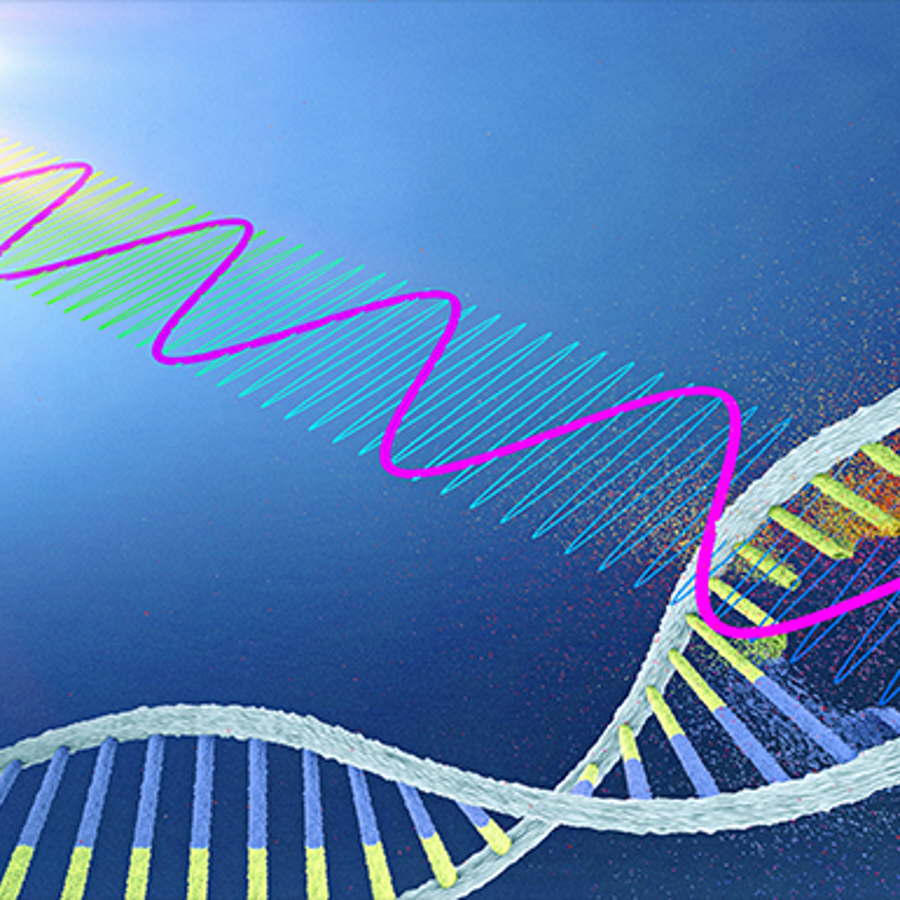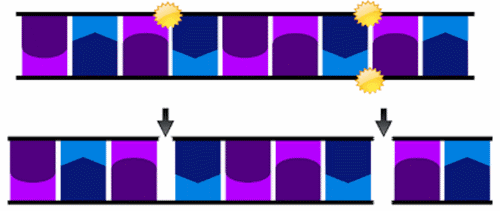
How does radiation damage DNA?
March 30, 2011

- Related Topics:
- Mutation,
- Environmental influence
A middle school student from California asks:
"How does radiation damage DNA?"
That's a great question because radiation can damage anyone's DNA. Radiation is really just high-powered particles or energy. When something like that smashes into your DNA (or most anything), it is definitely going to do some damage. Luckily, our cells are very good at repairing the damage so it takes a lot of radiation to do permanent harm.
Damaged DNA matters because your DNA has the instructions for making and running you. If these instructions get damaged, it can sometimes affect how well you run.
Like any good instructions, the ones in DNA are written up with letters. The high energy of radiation can mess up the instructions by changing a letter. It can also tear the DNA removing one, some, or even millions (!!) of these letters. This would be like ripping out anything from part of a page to a whole chapter of your personal instruction manual.
These changes can have a real impact on a cell or a person if the cell can't fix it in time. But not always.
Like any instructions, some mistakes can be tolerated. And luckily for us, our DNA has a lot of white space where a bit of damage is fine. When these parts get hit, our instructions are hardly affected at all.
But when critical DNA gets hit and doesn't get fixed, problems like cancers can happen. Or problems can be passed down to the next generation. As I said though, our cells are really good at fixing these mistakes so it usually isn't a problem unless our cells get overwhelmed by too much radiation.
That's what radiation does to DNA in general. To get at the specifics, I need to tell you more about how DNA works. Then I can show you how radiation can affect it.
You Want to Learn a New Language?
Your DNA tells your cells what to do. These instructions are written in a language called the genetic code. It's an easy language to learn because it has only four letters: A, C, G and T.
Each letter stands for the name of a different molecule:
A = adenine
C = cytosine
G = guanine
T = thymine
These molecules are called bases and certain ones stick together like puzzle pieces. So A pairs up with T and C with G.

And just like other languages, the genetic code isn't a big old pile of letters…bases are stuck together in a line just like words in a sentence. However, the "sentences" in this language are made up of super long words (much longer than supercalifragilisticexpialidocious!)

DNA reads just like words in a sentence.
In case you think a four-letter language is boring, here's a twist. A sentence of DNA has two strings of letters with one stuck on top of the other. Remember how your bases pair up (A with T and C with G)? Well, this makes a single strand of letters quickly find a partner to form a double strand. This double stranded DNA holds the instructions for making a living thing.

DNA is made of two strings of letters one on top of the other.
Like any set of instructions, the ones in DNA have to have most of the letters in the right order. Radiation can affect the instructions by removing letters, tearing out big chunks, or even whole chapters. And it can do these things in a number of different ways.
Radiation Can Damage Your DNA in Multiple Ways
Now that we are DNA experts, I can show you how radiation affects your DNA. One way is by actually breaking the long string of letters. This can happen to just one or both of the strands.
Your cells are pretty good at fixing one broken strand. So normally that damage is not too bad. But cells have trouble fixing the double strand breaks.

Radiation can break your DNA in different ways.
If double strand breaks don't get fixed, then part of your DNA can be deleted, duplicated or stuck some place it shouldn't (like to other DNA). Any of these problems can cause cancers and other genetic disorders.
Double strand breaks can also be big problems for you and your future kids' chromosomes. Chromosomes are how your DNA is stored in your cells. They are long pieces of DNA that each have some of the instructions for making you. You can think of them as the chapters in the book that is you.
A chromosome is actually a tightly bunched up string of DNA. We have two sets of them, one from mom and the other from dad. If a chromosome in a parent's egg or sperm is damaged by radiation, they could pass it on with some parts missing or misplaced. This can cause disorders like Cri-du-chat syndrome.
Another way radiation can cause problems is by changing the structure of your bases. It can change a base just enough that your cells can mistake it for a different one. For example, a G could look more like an A.
This tiny change can be a problem when your DNA duplicates itself, which has to occur every time a cell divides. So, if your cell reads that G as an A, then it would put in the wrong base when duplicating the DNA. This is because A's only pair with T's and C's only pair with G's. Now instead of a GC pair, you made an AT one.
This small change might put a glitch into a key bit of the DNA, modifying your instruction manual. This could cause cancer or other problems. Or it could also be completely harmless. Gray and grey are spelled differently but mean the same thing. It's the same idea with your DNA. It all depends where your code gets changed.
UV radiation in sunlight can damage your DNA by messing up the base pairing. UV light will often make two T's that are next to each other stick together making something called a dimer. Our cells have ways to fix this problem but if there are too many TT pairs, your cells can't deal very well with it.

Sunlight can sometimes cause two T's to stick together.
Some cells with lots of thymine dimers will die. You've seen this happen if your skin ever peeled after a sunburn. Cells that can't fix themselves and don't die could become cancerous. Melanoma is a common UV-induced skin cancer. Your cells have amazing ways of repairing "damaged" DNA but you can help them out by avoiding radiation when possible. Wear your sunscreen and try to stay away from uranium mines.

Author: Jan DeNofrio
When this answer was published in 2011, Jan was a Ph.D. candidate in the Department of Genetics, studying mechanisms involved in coral bleaching in John Pringle’s laboratory. She wrote this answer while participating in the Stanford at The Tech program.
 Skip Navigation
Skip Navigation
